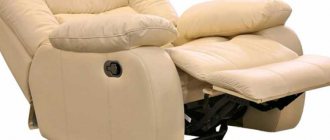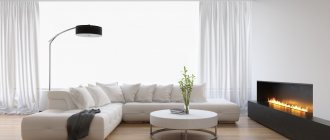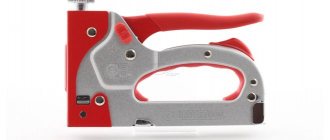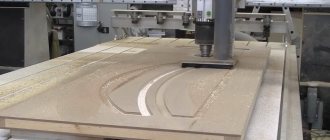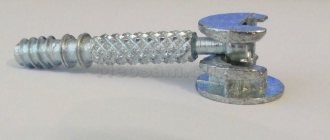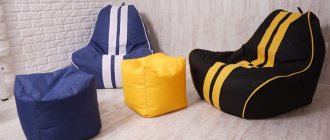A little history
A device for fastening sheet materials is called a stationery stapler . Stitching occurs using a thin wire that pierces several pieces at once. The owner of the first such device was the French king Louis 15 in the 18th century. It was rarely used as a tool; it was more used as a toy.
A century later, when the rapid development of science and industry began, and with it the office, through the efforts of John McGill, who improved this mechanism, the stapler came into use among all bureaucrats in the world.
A real clerk
Recent Entries
Categories
Hashtags
We are surrounded by staples, they are used to fasten a cash receipt and a sales receipt written by hand, a stack of bills for an apartment, a candidate’s resume of a couple of sheets. Staples all around.
It really infuriates me when you try to punch three pieces of paper and the staples get stuck inside the stapler or bend on the paper.
Let's figure out why this happens.
- The stapler is faulty. For example, the output hole of the staple head is deformed, then the staples get stuck inside.
- The stapler contains the wrong size staples. The secret is in the same staple head - it is calibrated for a specific size. If there are smaller staples, they will fly through several pieces and get wrinkled inside. If more, they will get stuck at the exit. Although, there is always another option. If you are very strong, the staples will not get stuck, but the exit hole will break.
- You are trying to punch through more sheets than the stapler and staples are designed to handle.
- You bought cheap staples. A low price does not appear out of the blue. This means that the manufacturer saved at some stage of production.
In this article I won’t focus on staplers (we’ll get to them later), but on staples. Let's take a closer look at where and what we were missing, how to get honestly working staples and what to look for when purchasing.
In the photo: above, this is what the packaging and contents look like when the manufacturer saves on everything. In the lower part, brackets with different coatings: painted, uncoated, copper-plated and galvanized.
Making staples is a simple cutting and bending process. In a good way, they are made from uncut metal wire. This means that it is the same diameter along its entire length and all staples in the block will be even. However, the price will drop significantly if the wire is made of aluminum rather than iron. Aluminum is cheaper, but it is also softer, which means it bends and breaks more easily. Good staples are made of steel, and excellent ones are made of stainless steel. Good to know: all staples with a leg height greater than 10mm are made of steel.
To protect the staples from environmental influences and for beauty, they are coated with something. Here is a list of commonly used coatings:
- Painting is simply paint and serves purely decorative purposes.
- Galvanizing is the cheapest coating method and protects against rust. Over time, the staples become a greenish-red color.
- Copper plating is a protective and decorative coating, which is why the staples are pink or red in color. Protects against rust.
- Nickel plating is a cool plating method that makes the brackets look chrome-plated and will not rust for a long time.
It is logical that the type of coating does not affect the price. But we don’t save on nerves, right?
The staples should not fall apart when you take them out of the box. Moreover, the block must withstand a fall from a height of one and a half meters and not fall apart. To do this, the staples are glued. The amount of glue should be such that the staples do not spread throughout the box, otherwise there will be a mess inside. If the glue is applied unevenly, they will get stuck and bend inside the stapler. The same thing applies if there is a lot of glue, but I have never met such a generous manufacturer.
Read also: Latre for cutting foam plastic
When purchasing, pay attention to whether there is an inscription on the box that the staples are sharpened or sharpened. The legs of the staples are sharpened from the outside or inside. This tiny adjustment makes it easier to pierce the paper and reduces the chance of the staples bending. Of course, unless you decide to get into the Guinness Book of Records and punch one hundred sheets with staples No. 10.
Selection of bracket size:
Usually, staples are purchased along with a new stapler. Or to one that has just been stolen from someone else’s table, repainted and with the numbers changed. Therefore, we look at what number of staples the stapler is designed for, and based on this, we buy staples. It happens that nothing is indicated on the stapler, that’s how the Chinese are. Then we turn on the logic mode, if the stapler is small, then 90% there are 10 staples, if the stapler is medium or large, then staples 24/6, or take it with you to the store. I did this when I needed to buy a faucet for a mixer. I turned off the water in the apartment, unscrewed the faucet and went to the market to pick it up. Profit!
One day, I will write about staplers in detail, but I will give some information right now. Before purchasing, decide what you need the stapler for. For use at home or everyday work in the office, with a small number of sheets, “number 10” is ideal. It punches up to 12-16 sheets (we are considering all the available options for purchase, sold on every corner), is small in size and does not take up space. Just what you need! For regular work with documents and a decent amount of paper, for example in the accounting department or secretariat, a more powerful companion is suitable - the number 24 stapler. Typically, such staplers punch up to 30 sheets, this is indicated on the packaging (we do not consider special perverted cases). Yes, 24/6 staplers are larger sizes. Yes, they take up more space. But they are also more reliable, designed for intensive work and active use in a 24 to 7 format. Such staplers use staples number 24/6 and 26/6, if indicated on the package.
Damn it, they kept it a secret behind seven seals. I scoured the Internet, looked through the available catalogs of manufacturers that I could reach, but there was very little information. But why?
Here are some versions:
- "Classical" sounds like this. The first number is the bracket type. To keep things simple, we called it a conventional unit. Supposedly, it includes the width of the staple, the cross-sectional size and the steel grade of the wire. This is the most popular version, found on almost all office resources.
Versions for the curious, clerks and deep immersion in the topic:
- OK. There is another version. I'll call it "mixed". Information of this kind is less common, but still. According to this version, the first digit of the fraction is tied to the American wire thickness marking system (American Wire Gauge (AWG)). In it, the lower the value, the thicker the wire. Smart guy mode activated: wire is made by drawing. It is pulled through the decreasing holes of the die to the desired diameter. The number indicates the number of pulls. AWG gauges indicate not only the dimensions (diameter, cross-section) of the wires, but also the sizes of rods, rods, tubes, and the same wire for staples.
- And here is the version from the manufacturer KW-Trio (Taiwan) (information from the official website). In staples with fractions, such as 24/6, the value in the numerator (24) determines the number of staples per inch. The lower the number of staples per inch, the thicker the wire from which the staple is made. Actually, that’s right, I went to the warehouse and looked. Here is a photo.
Staples of different numbers, different manufacturers as an example
Glory to the hares, the second digit in the fraction does not raise any questions - the length of the leg is in mm. When choosing a staple for fastening, know in advance the thickness of the booklet you are going to punch. To do this, you need to press it down a little + take a margin of 3-4 mm for bending the bracket.
Voice from the audience: - What about staples No. 10? Answer: - No way. According to the dictionary. Just remember - these are the smallest office staples. It's not true, No. 21 exists, but it's a mythical beast like Pikachu. In reality, no one saw him. And if he did, he was on drugs. Why they are called that, why the hell they don’t have a fractional number, I don’t know, there is no information. I think the manufacturers don’t know either, they’re just acting out of old memory.
For reference:
And here is a table of correspondence between the markings of staples and the number of sheets being fastened.
Correspondence of staple numbers to the number of sheets being punched
Just two main thoughts. First, all staples are good, choose the right ones for the situation. The second is to buy cheap staples - save pennies, but lose rubles. I am not a fan of buying staples from the same manufacturer as the stapler. Check it in practice, staples don’t cost crazy money, experiment. Over time, brands you trust will emerge. When choosing staples, pay attention to the packaging. Quality of workmanship: printing pictures, gluing and design will say a lot even before purchase.
Also, the packaging must indicate:
Example of proper staple packing
I'm not saying you shouldn't buy cheap braces. I'm just warning you, don't expect a miracle. If you use a stapler once a year, then it doesn’t matter what staples are loaded into it. Yes, there is a chance that you will punch two leaves on the third try, well, never mind, there are a thousand in the box. Buy aluminum, without sharpening and coating, from an unknown manufacturer, with the expectation that 30% will be spent on defects - not a big loss. But if your productivity is a little higher, you work with documents regularly, and their appearance and neatness matters. Welcome to the club!
Types of staplers
Devices that perform the functions of fastening sheet materials are usually divided into construction, furniture and office. However, the difference between the first two is only symbolic. Therefore, the classification can be taken as follows:
- Device for office needs.
- Construction stapler (tacker).
- Special device for baguettes, corrugated cardboard boxes, etc.
A stationery stapler not only pierces sheets, but also bends staples from the inside. This is the only difference in the operating principle. Therefore, it makes sense to get acquainted with the device using a construction sample as an example.
Fastening tools for construction
The principle of operation of a construction stapler is similar to the process of driving nails. With its help, the staple passes through the top layer or more than one (the total thickness should not be greater than the length of the staple leg). In the extreme material, the ends of the wires remain sticking out on the reverse side, like the point of a nail that has come out. Using friction, the sheets stick to the last layer.
A richer classification among methods of driving a device. In this category they are:
- Mechanical hammer and lever.
- Pneumatic.
- Network electrical.
- Rechargeable.
The most popular devices are mechanical lever ones. Hammers have not become so widespread because of their operating principle - with a blow. Therefore, with their help it is not always possible to accurately drive the bracket into place. And it needs a lot of space to spread out.
Which to choose?
Construction staplers are divided into several types according to certain parameters. For example, according to the principle of operation - mechanical, electric and pneumatic tools.
By purpose:
- Typical (classic) stapler. It usually uses U-shaped staples, but special nails can also be installed. It has a universal purpose.
- The cable stapler is capable of securing cables and wires with a diameter of up to 8-10 mm, for which rounded staples are used. Such fastening can be carried out in electrical networks with a voltage of no more than 50 V. At higher voltages it cannot be used due to the risk of a short circuit. The main purpose is telephone, computer, communication lines.
- The packaging tool is designed to work with cardboard (including corrugated cardboard) and various film materials. It resembles a stationery device, because... bends the ends of staples, but has significantly greater power and size.
- The window option is capable of securing glazing beads and other elements using metal pins. The length of these fasteners can range from 10 to 50 mm, depending on the principle of operation of the stapler.
- Thacker uses V-shaped staples. This fastener design allows you to connect workpieces located at an angle to each other. An example of use is assembling photo or painting frames.
- The rivet stapler (rivet gun) is capable of installing aluminum, copper and steel rivets.
- The staple hammer uses the inertial principle, i.e. it is used like a hammer, but the impact force is increased due to a special mechanism. The main purpose is installation of roofing and floor coverings.
According to technical characteristics:
- Impact force . This is an important criterion for choosing a tool, because it determines the depth of driving in the fastening element (staple, nail). For household construction, this parameter is in the range of 3-16 mm. Low-power tools work with staples up to 8 mm high, while higher-power tools work with staples higher than 10 mm.
- Bracket width . The area of pressing of the elements when they are fastened depends on this indicator, and therefore the speed of the operation and the reliability of the connection.
Mechanical
The most widespread is the mechanical stapler, the operating principle of which is based on increasing physical strength using a spring mechanism . During operation, the user presses the handle with his hand, which bends the spring.
We recommend: Homemade and manual machines and devices for sharpening knives. How to make a sharpener with your own hands?
At the maximum point of bending, the spring is released and all its accumulated energy is directed to strike the fastening element (clip, pin or nail). This force is enough to drive it into the base.
The spring in a mechanical stapler can be of a twisted or plate (spring) type. When choosing a tool, it is better to give preference to the second option, because it provides significant impact force with almost complete absence of recoil. In modern designs, the impact force is adjustable, which makes it possible to configure the tool to work with materials of different hardness.
The main disadvantage is the need to apply significant effort when breaking through a solid base and physical fatigue during prolonged work.
Electric
An electric stapler differs from a mechanical tool in that the spring bends using electricity . When you turn on the device, it immediately enters the ready state, and to strike the bracket you just need to press the start button. This stapler can operate from mains power or a built-in battery.
Usually, preference is given to battery power, because... The connection to the outlet is eliminated and there is no cord that interferes with operation. The most commonly used batteries are nickel-metal hydride type (2 cells at 14.5 V) and lithium-ion type at 18 V. The second type of battery is the most reliable.
The main advantages of an electric stapler are the elimination of physical effort, which is important for large amounts of work; acceleration of work; convenience and practicality. Disadvantages - higher cost, less reliability and greater weight of the tool.
Pneumatic
In a pneumatic stapler, the shock load is provided by compressed air .
Such a tool can be produced in stationary and manual versions. In the first case, the air supply is regulated by the pedal, and in the second - by the start button.
To operate a pneumatic tool, you need an air compressor , which creates the main disadvantage - the bulkiness of the equipment.
Among the positive aspects of this stapler, there is a locking system against accidental inclusions, prevention of jamming of staples, and adjustment of shock load. The most important advantage is the highest speed of operation and enormous penetrating ability.
note
The pneumatic tool can handle nails and studs of maximum length.
Types of staples
All kinds of staples are used to fasten various materials. The most popular are staples in the shape of the letter P. There are also staples in the shape of a T and inverted semicircular U-shaped ones. For fastening pipeline cables, semicircular types are used, the sizes of staplers are for staplers. They come in two types of markings:
- In the form of a semicircle with a diameter of 4.5 millimeters, a stem height of 9-11 millimeters and a standard thickness of 1.25 mm. This is a type S or number 28 paperclip.
- Fasteners type L or number 36 have a slightly larger diameter (6 mm). Legs with a height of 9-10 millimeters of standard height
The most commonly used devices are staplers using U-shaped staples. They are distinguished by the following indicators:
- Diameter.
- Leg length.
- Length and thickness of the back.
The length of the leg determines how reliable the connection will be and the overall thickness of the fastened part. For thick connections you need a more powerful tool; a weak one may not penetrate the entire foot and the fastening will fall apart.
Thin back paper clips are needed for invisible fastening. Most often they are used in professional instruments.
The stronger the material, the less thickness of the leg is needed: 0.75-0.8 mm. For thin paper, choose thicker paper clips: 1.25 or 1.65 mm.
Correct selection of staples according to tool model and type of work
To choose the right consumables for the job, you need to focus on a number of criteria:
- the type of fastener for which the staple gun in use is designed, as well as its shape;
- the material of the base surface into which the fasteners are to be driven;
- future conditions in which the fasteners will be located after connecting the parts;
- the material from which consumables are made;
- sharpness of the ends of the staples;
- quality of consumables.
For instructions on the appropriate size and type of charging fasteners for the model of staple gun you are using, please refer to the packaging or the tool's instruction manual. These are mainly U-shaped consumables. The fastener number on the marking is represented by 2 numbers: the first indicates the width of the bracket, and the second indicates the height of its leg.
The choice of consumables from the size range designated by the staple gun manufacturer is based on the magnitude of the future load on the fastener: the higher its value, the larger the dimensions of the fastening element should be . If the base material is hard, then steel or hardened staples are suitable. It is better that they have pointed ends - this will ensure easy driving in.
When it is necessary to make a connection point that is not subject to loads as inconspicuous as possible, consumables of the smallest possible size should be used.
For use in wet conditions, copper, aluminum, galvanized, or stainless steel staples are suitable. The optimal option depends on the hardness of the base and the degree of the upcoming load.
Raw materials for paper clips
The different purposes of the staples also determine the different materials for the production of these consumables. They must meet various requirements: rigidity, corrosion resistance, etc. Therefore, all brackets are metal.
Aluminum fasteners
These are the cheapest, but at the same time acceptable quality, paper clips. That is why tools using such fasteners are the best-selling. In addition, they do not rust. But other qualities make their use limited in comparison with analogues from other materials.
Additional options
When buying a stationery stapler, few people might think that it can be further improved. However, this is not the case , and this is confirmed by new models that manufacturers regularly release in order to improve their ease of use.
- If you want to get one of these models at your disposal, we recommend that when choosing a stapler, make sure that there is a plastic footrest or rubberized inserts at the bottom of the body. They will help protect the table surface from scratches and other mechanical damage.
- Some models can be additionally equipped with such a useful device as a destapler. Its main purpose is to straighten staples. It may be required if you decide to separate sheets of paper that were once fastened together. Of course, you can use scissors or nails for this, but this is not very convenient, and after such a “barbaric” method, the sheets will no longer look as aesthetically pleasing as before.
Popular consumables for stitchers
The most popular types and sizes of staples for construction staplers are 53 and 140 numbers. The first has the following values:
- The height of the leg is 4-14 millimeters.
- The back is 0.7 mm thick.
- Width 11.3 mm.
For 140 paper clips, respectively, the height is 6-14 mm, the width is 10.6 mm, and the thickness is 1.25 mm. There are staples for office staplers, the types and sizes of which are determined by the number of sheets punched in one cycle. The most common type of paper clip is 10. For other series, this will be a fractional number, where the first digit is its number, the second is the height of the leg. Therefore, when purchasing these products, you need to know which products are suitable for this particular stapler model.
Types and sizes of staples
Most consumers associate staples with U-shaped products, but their types are more varied. They can be classified as follows:
By form:
According to the material:
- steel:
- galvanized;
- stainless;
- copper;
- aluminum.
According to technological capabilities:
In addition to different types, staples differ in size, shape and material. To select the right fastener for a specific model, you need to read the information on the sticker.
If there is none, the stapler needs to be brought to the store, and any sales consultant will select fasteners for it. Information can also be found on the Internet. Each manufacturer publishes data on models and technical information about them on their website.
Fastener dimensions
The regulated fastening parameters are:
The height of the fastening element must correspond to the thickness of the element being attached. The thicker the element, the higher the bracket size should be. The thickness is selected for aesthetic reasons. If the fastener is located outside in an unclosed state, then the bracket will be less noticeable with a minimum thickness.
The length is selected depending on the material being attached. If it is quite thin, like plastic film, then the length should be maximum. And for dense materials, a medium size is sufficient.
